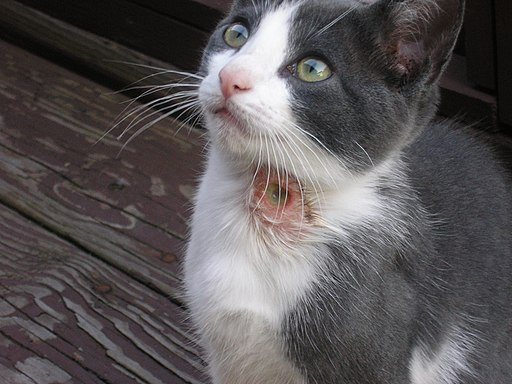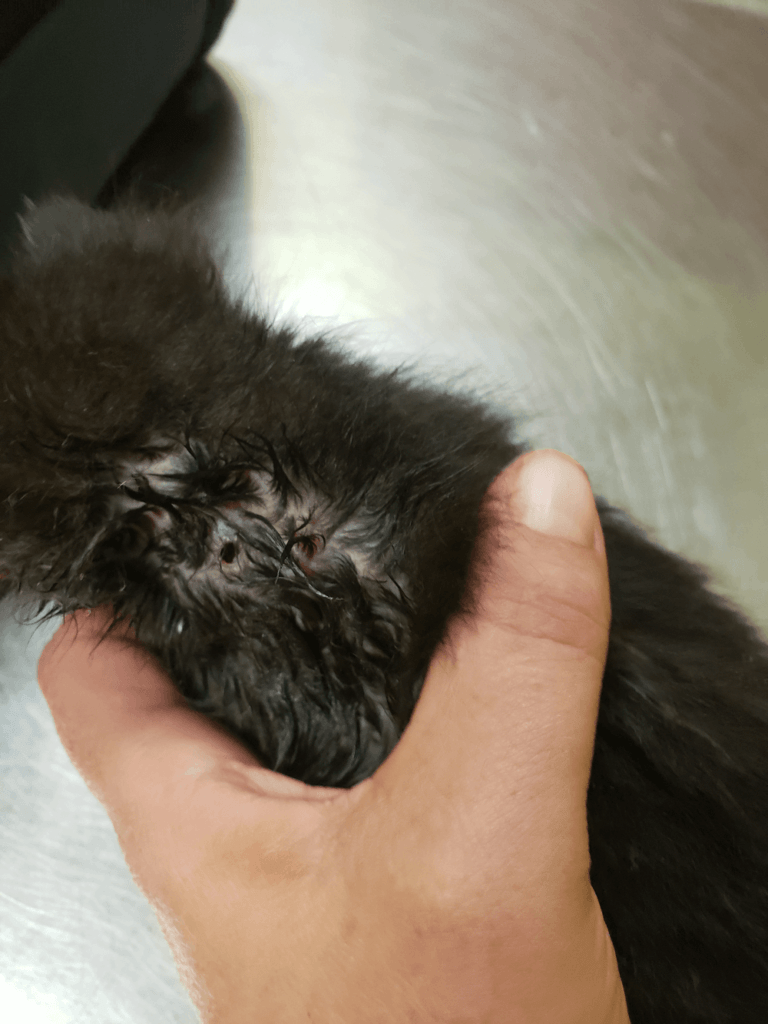
Feral and community cats face a lot of danger living their lives outside. Bot fly larvae in cats might be uncommon, but they are one of those dangers that often require a vet’s intervention. It also can be fatal in certain cases.
But we’ll get to that in a moment.
Read on to learn about bot flies and how they may affect our beloved colonies of cats.
Disclaimer: I am not a veterinarian. This article is for educational purposes only and should not be used to diagnose or treat any illness or disease. Please discuss any health issues regarding your pets or cat colony with your veterinarian.
Disclaimer: This post contains affiliate links. I may earn a small commission from qualifying purchases, at no cost to you. Read the Affiliate Disclosure for full details.
Graphic Post Warning: Some pictures are a little gross. Fair warning!
What are Bot Flies?

Bot flies (also spelled botflies) are a name given to a type of parasitic non-biting fly. They are also called warble flies, gadflies, etc. The adults usually have a bee-like appearance and hairy, but they don’t have bristles. Or stingers, obviously.
Bot fly larvae are parasites to various mammal species. They are considered true parasites because they don’t kill their host animal, normally.
There are many species of different types of bot flies. They tend to be somewhat species-specific, which means that there are horse bot flies, human bot flies, rodent bot flies, etc.
Those particular bot flies rarely infect hosts outside their preferred species. But it CAN happen. Sometimes the parasite doesn’t thrive well inside other host animals. And sometimes they do just fine.
Bot flies of various species can be found all over the United States and Canada, including Alaska and Hawaii. Yes, you DO have bot flies in your state. Don’t worry, though! Human-specific bot flies don’t often occur in the United States. They are usually found in Central and South America. However, other species of bot flies can infect humans.
Bot flies live a very short time as adults. But they DO mate and lay eggs on or near their preferred species. Then the adult flies die.
When the eggs hatch, the larvae then search for an opening in an animal (or human) that they can burrow into. This can include the nose, mouth, ear, and open wounds. These tiny larvae with then migrate THROUGH the animal’s muscles or tissues to a spot just below the skin, where it will encyst.

This is where they will grow eat and grow: inside the tissues of an animal or human. It is this stage that is often called warbles. Warbles are basically the lumps caused by the larvae living inside the living tissue of a host.
When the larvae are big enough, they will (usually) exit their hosts to become pupae. After the pupae hatch, the adult flies emerge, to start the process all over again.
There are some variations in species and how their life cycles differ, of course. Horse bot flies, for example, will usually lay eggs on the legs of a horse, and newly hatched larvae will travel into the mouth and nose, then through the stomach and digestive tract during their life cycle.
And how all the different bot flies mature is irrelevant. We want to talk about cats!
What Type of Bot Fly Larvae Infects Cats?
So is there a cat bot fly?
Nope!
Cats are accidental hosts of the rodent bot fly, which is the genus of bot flies known as Cuterebra. There are 78 known species of rodent bot fly. Twenty-six of those species can be found in the United States and Canada, as well as Mexico and neo-tropical regions as well.
Cats are accidentally infected by this fly, they are not the target. Which is why it is not all that common to see, like fleas and roundworm infections are. Although vets likely see more cases than your average cat caretaker or cat rescuer sees.
About Cuterebra

Different species of rodent bot flies often target specific areas of the body in different hosts. This is just simply the way they evolved. One species might target the throat region in cottontail rabbits (Cuterebra horripilum), while another may end up targeting the tail region or abdomen of deer mice (C. fontinella).
Bot fly larvae look like large grubs, basically
The development of the larvae within the host varies from 19-38 days in small rodents to 55-60 days in jackrabbits.
After leaving the host, a larva will develop into a pupa in the soil, leaf litter, and other debris on the ground. The pupa stage can last anywhere from 28 days to 11 months, depending upon the species of rodent bot fly and the environmental temperature.
After the adult fly emerges from the pupa, they appear to be somewhat bee-like in appearance and live for only around 2 weeks. They will mate shortly after emergence and lay their eggs before dying.
Cuterebra flies are VERY common in North America.

How Does a Cat Get Infected with Bot Fly Larvae?

A cat can get infected by bot flies by brushing against grass or other greenery in areas with a lot of rabbits or other rodents.
Cuterebra flies tend to lay their eggs in the grasses around rabbit burrows and other fun rodent-infested places. The eggs hatch once they detect the body heat of an animal. Then the larvae hop (probably crawl, not actually hop) onto the first animal that brushes by them.
Most cases of bot fly infestation in cats occur on the head and neck for this reason. They’re often investigating a rabbit burrow or other rodent home.
Bot Fly Larvae Symptoms in Cats
The early stages of warbles is rarely evident with an external examination of the skin. Most cases only become noticeable after the larva grows enough that there is swelling beneath the skin. This swelling is usually felt or seen.
A small breathing hole is often seen just above the swelling. This hole will grow larger as the larva becomes fully mature and is preparing to leave the cat. It often leaks fluid and pus.
Sometimes NOTHING is noticed until after the larva has already left the cat’s skin, and the left-over hole has become infected or turns into an abscess.
A bot fly larva is not dangerous on its own. It is not usually deadly and will leave the cat all on its own. Most of the time, it is the infection caused by the larva and the empty cyst that cause cats the most problems. Untreated, it can be fatal.
And most cats WILL develop an infection or abscess.
If the bot fly larva ends up inside the cat’s respiratory system, then respiratory symptoms may be observed. These include cough, sneezing, gagging, nasal discharge, and shortness of breath.
If the larva has traveled to other areas inside the cat, such as the brain, symptoms can be varied and include dizziness, circling or other abnormal behavior, head tilt, confusion, blindness, weakness, paralysis, lethargy, lack of appetite, fever, seizures, lesions, and even death.
Treatment for Bot Fly Larvae Infestation

A bot fly larva in a cat IS a veterinary matter. You should NEVER treat at home or remove the larva from the skin by yourself. If you rupture the larva, you can introduce toxins into the cat’s bloodstream. You increase the risk of infection. You may not remove the entire insect from the warble. You WILL also need antibiotics that you can only get from your veterinarian.
Treatment will depend on whether or not the bot fly larva is still present in the skin.
If the bot fly larva has already left the cat, then oral antibiotics, wound treatment, and removing dead tissue may be performed. Sometimes stitches or surgery in rare cases might be necessary.
If the bot fly larva is still present in the wound, then it is removed first.
If the bot fly is living inside the cat and cannot be easily pulled out, anti-parasitic meds may be prescribed by the vet or other surgical options might become necessary.
If you’ve already been to the vet, and are currently caring for the wound left behind, you can flush the wound with a chlorhexidine wound flush to help keep the wound clean and disinfected. But that is NOT to be used instead of proper veterinary care. Oral antibiotics will save the cat or kitten’s life.
Vet Ranch has a video of a bot fly larva removal, if interested. Be warned. It’s gross.
Warbles Prognosis
If there are only one or a few bot fly larvae in the skin, then the cat should fully recover with little to no problems as long as infection is properly treated.
If there are a LOT more larvae involved or the bot fly larva has migrated to a sensitive area, such as near a nerve or sensitive tissues or organs, then the cat may be in trouble of having permanent issues or even in danger of death.
Bot fly larvae aren’t inheritantly dangerous by themselves, but like any sort of malady, the numbers and locations make a HUGE difference.
And not treating the wounds left behind by bot fly larvae can be deadly.

How to Prevent Cats From Getting Bot Fly Larvae

The only real prevention is to keep your pet cats indoors and prevent them from hunting rodents.
For outdoor cats, such as feral cats and barn cats, this is a problem. You really cannot prevent it as the cat is free to go where they wish. You could poison all the rodents on your land, but that seems a bit inhumane to do just to prevent a relatively rare – and minor – parasite that doesn’t specifically target cats at all.
If it is not possible to keep a cat indoors – such as for those of us caring for ferals or strays – then the best option is to regularly inspect the cats as best you can so that you notice any signs of bot fly larvae infection as soon as possible and make sure that all cats are on heartworm, flea and tick medications. This may help to stop the larvae from developing or kill them before they infect the cat.
The earlier the larva is removed, the better the cat’s chance of healing with no scarring or complications.
Rodent Bots are Gross
Rodent bot fly larva are a gross little parasitic grub, but it is usually easily taken care of by a veterinarian.
They aren’t very common in cats, so chances are you won’t even see them in your barn cats or cat colony at all.
But it’s certainly possible. And one reason why heartworm, flea, and tick medication like Revolution or such are so helpful as they may help prevent bot fly larvae from infecting your cats.
Related Post: What’s the Best Flea Treatment for Cats?
Do you have a horrific bot fly larvae in cats story to share? Then comment below!
Lovies!
